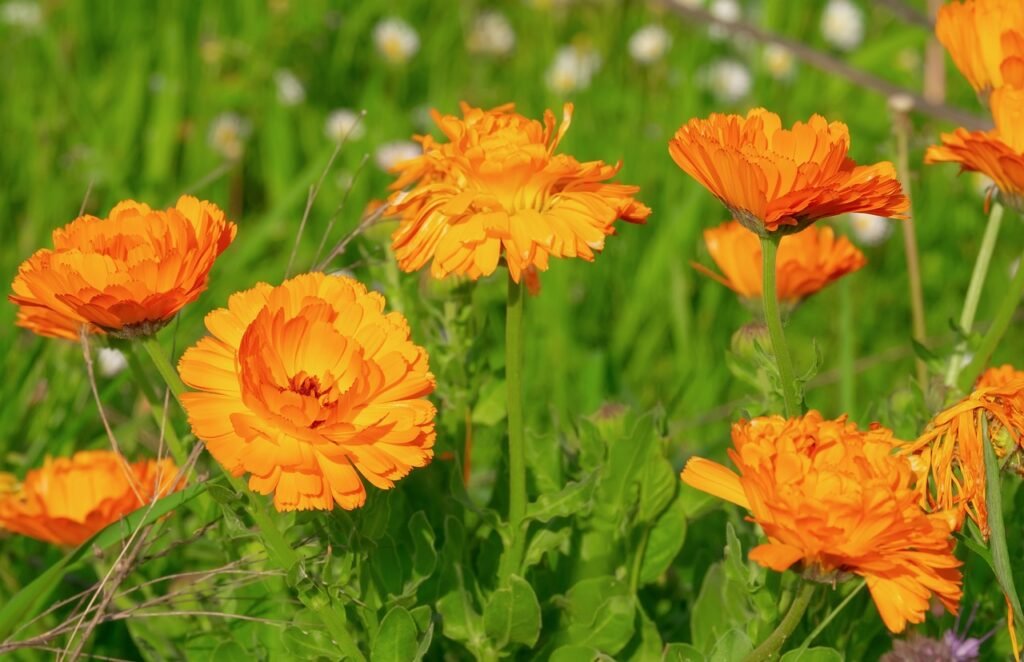Calendula, also known as marigold, is a beautiful flowering plant with vibrant orange or yellow petals that bloom throughout the summer months. It is easy to grow in sunny locations and is known for its medicinal properties, such as soothing the skin and relieving inflammation. Whether used as a decorative addition to your garden or as a natural remedy, calendula is a versatile and beneficial plant to have.
About Calendula:
Calendula is a beautiful flowering plant that comes in various types, including Pot Marigold, English Marigold, and French Marigold. Each type has its own unique characteristics and growth habits.
Calendula is an annual plant with a relatively short life cycle. It typically blooms from late spring to early fall, providing a vibrant burst of color in the garden.
Characteristics:
Calendula is known for its ability to attract bees, butterflies, and hummingbirds, making it a great addition to pollinator gardens. It is an easy-to-grow and low-maintenance plant, making it suitable for beginner gardeners. Some species of Calendula are edible and have a subtle, peppery flavor, making them a delightful addition to salads or teas. Calendula also has an extended bloom time, ensuring a longer period of enjoyment in the garden. Additionally, its bright and cheerful flowers make it a popular ornamental plant. Calendula is a fast-growing plant, quickly filling in empty spaces in garden beds or containers.
Growing Conditions:
Calendula thrives in well-drained soil and prefers full sun to partial shade exposure. It can tolerate a wide range of soil conditions but thrives in loamy or sandy soil. Calendula is relatively drought-tolerant once established and prefers moderate watering. It is best to sow the seeds directly in the garden after the danger of frost has passed.
Resistance:
Calendula is generally resistant to deer and rabbit damage, making it a great choice for gardens prone to these pests. However, it can be susceptible to diseases such as rust, fusarium wilt, downy mildew, and powdery mildew, especially in humid conditions. Regularly inspecting the plants and providing proper air circulation can help prevent these diseases.
| Season | Depth | Height | Spacing | US Hardiness Zone |
|---|---|---|---|---|
| Spring and Fall | 1/4 to 1/2 inch | 24 to 30 inches | 8 to 18 inches | 2 to 11 |
Plant Care Instructions
Light Requirement
Calendula plants thrive in full sun but can also tolerate partial shade.
Water Need
Water Calendula plants regularly, keeping the soil consistently moist but not waterlogged. Allow the top inch of soil to dry out before watering again.
Fertilizer
Calendula plants do well with a balanced fertilizer, such as a 10-10-10 or 20-20-20. For organic options, consider using compost or an organic granular fertilizer.
Pruning
To encourage continuous blooming, deadhead spent flowers regularly. This will also help prevent the plant from self-seeding. If the plants become leggy, you can prune them back by about one-third to promote bushier growth.
Toxicity
Calendula plants are considered non-toxic to humans and pets, making them a safe choice for gardens.
Common Issues
Common issues with Calendula plants include powdery mildew, aphids, and spider mites. Regularly inspect the plants for signs of these pests or any other diseases and take appropriate measures to control them.
Culinary Benefits:
- Calendula flowers can be used to add color and flavor to salads.
- They can be used to garnish soups or stews.
- Calendula petals can be used to make herbal teas or infuse oils.
- They can be used as a natural food coloring agent.
- Dried calendula petals can be used in baked goods like cakes and cookies.
Medicinal Benefits:
- Calendula has anti-inflammatory properties and can be used to soothe skin irritations.
- It can promote wound healing and is often used in ointments and salves.
- Calendula can help relieve symptoms of skin conditions like eczema and psoriasis.
- It has antimicrobial properties and can be used to treat minor cuts and scrapes.
- Calendula can be used as a natural remedy for digestive issues like upset stomach or indigestion.
- It has been traditionally used to alleviate menstrual cramps and symptoms of menopause.
Companion Plants for Calendula:
- Marigolds: These vibrant flowers not only add a pop of color to your garden but also attract beneficial insects that help control pests.
- Nasturtiums: With their trailing vines and vibrant blooms, nasturtiums help deter aphids and other pests from attacking your calendula.
- Zinnias: These colorful flowers attract butterflies and bees, which aid in pollination and add beauty to your calendula patch.
- Cosmos: Known for their tall stems and delicate flowers, cosmos not only provide shade for calendula but also attract hoverflies that prey on aphids, protecting your plants naturally.
In conclusion, Calendula is a beautiful and versatile flower that is easy to grow and care for. Its vibrant colors and healing properties make it a great addition to any garden. Whether you want to brighten up your outdoor space or create homemade remedies, Calendula is a wonderful choice.

